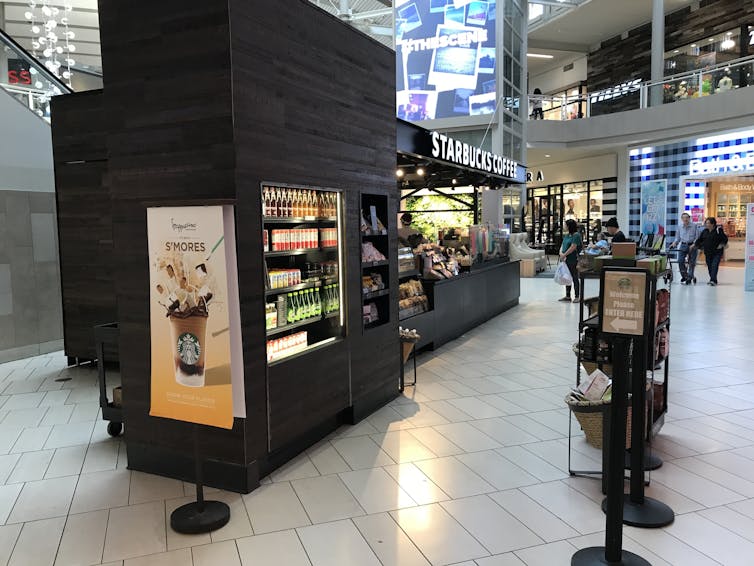More businesses are trying mobile apps to lure and keep consumers
As businesses' branded mobile apps become more common and popular, how are they affecting shoppers' buying habits?

Intense retail competition has led old standbys, such as Sears, to close dozens of stores. Walmart is venturing online more. And Amazon is expanding offline, opening stores and buying Whole Foods. The fight for retail dollars is fierce, and the battleground will soon migrate into the palms of customers’ hands – via apps on their smartphones.
This isn’t just happening with mega-retailers. Movie chains and pet supply stores are increasingly connecting with their customers through their own branded apps. Zumiez, a specialty clothing chain with 600 stores in the U.S., has an app. Scooter’s Coffee, an Omaha-based coffee chain with 200 stores, has one too. So does New York Pizza Oven, a single pizza parlor in Vermont.
Mobile apps are becoming key ways for customers and retailers to interact. Our recent analysis of data from a large U.S. retailer of video games and electronics (whose name we agreed to keep confidential) found that apps can even affect consumers’ offline buying habits.
Growth in use – and spending
The number of people who have the option to use mobile apps is skyrocketing. More than 70 percent of the world population will own a smartphone by 2020. And they’ll spend more than 80 percent of their on-phone time using task-specific apps.

Letting buyers learn about products, discover deals, locate nearby stores and even place orders in advance is a huge business opportunity. At Starbucks, for example, an app allowing people to order and pay on the go – just swinging into the store for pickup – helped customers avoid standing in line and waiting: Over five years, 20 percent of its sales shifted to online transactions.
Research has also begun to show that people who use mobile shopping apps buy more than they might otherwise. After individual shoppers started purchasing using eBay’s mobile app, their purchases from eBay’s website increased. Similarly, a tablet app from major Chinese e-tailer Alibaba led customers to spend about US$923.5 million more each year with the company than they would have without the app. Some of that increased spending is from shoppers using the app to buy impulsively – making one-off purchases of items they are interested in, or adding items to larger orders.
Our research recently found a new dimension to this app-related spending boost. Over 18 months, customers who downloaded the branded app of the retailer we studied spent 30 percent more in stores than they would have without the app. We can infer this by looking at data on customers’ spending before and after the app was installed, and by comparing that to the spending of a random sample of customers who had similar demographics and shopping behavior before the app launched.
We learned that most of the increase was because customers used the app to find out about products before buying them. For example, by closely analyzing the data on app use and purchases, we could see these customers started increasing purchases of lesser known video games when they started using the app.
App users return products more
While shoppers who use a retailer’s mobile app tend to buy more online and in stores, we find that they are also more prone to subsequently returning the products they purchased.
In particular, customers who use a retailer’s app tend to return products most often when they purchased those products on discount, and within seven days of making the original purchase. Apps often make it easier to purchase items on impulse. When customers receive some of the items and are dissatisfied, they regret the decisions and return the items.
Even taking into account the high rate of returns, app users spend more both online and in physical stores. But that’s when the apps work as customers expect them to.
App failures –- and consequences
Apps that load information slowly or crash frequently can deter not only online purchasing, but in-person spending, too. Surveys show that more than 60 percent of users expect an app to load within four seconds. And our ongoing research suggests that more than half of users will abandon an app that freezes or crashes frequently.
App slowdowns can be costly. One estimate suggests that if each Amazon webpage took just one second longer to load, the company’s sales could drop as much as $1.6 billion a year. For smaller retailers, a similar drop of 2 to 3 percent would be a smaller dollar amount but still a significant blow.
Our ongoing research with Stanford’s Sridhar Narayanan suggests that poor app performance reduces users’ in-store spending too. Specifically, we studied how shoppers react when an app is not accessible for five or six hours, due (users were told) to a server error. Our preliminary results suggest that in the following two weeks, those shoppers spent 3 to 4 percent less in stores than they would have otherwise. Less-frequent customers reduced their spending even more than the company’s more regular shoppers.
Interestingly, customers who experience app failures spend less in stores, but their online spending remains unchanged. A deeper analysis indicates that when a retailer’s app fails, shoppers often go to the retailer’s website to complete their intended transactions. But the negative experience from app failure discourages them from buying more in the retailer’s store.
Our research illustrates some ways mobile apps can be a double-edged sword for customers and retailers alike. Shoppers can use apps to learn more about prospective purchases, be inspired on the fly and save time at the cash register. But if the software fails, they may be frustrated, discouraged and even spend less at physical stores. Retailers can see increased sales and faster transactions, but may have to handle more returns – though they’ll still make more money. The longer-term effects of mobile apps on the retail business have yet to be seen, of course, but in an ever-changing landscape, companies and customers alike will be exploring the options.
The authors do not work for, consult, own shares in or receive funding from any company or organization that would benefit from this article, and have disclosed no relevant affiliations beyond their academic appointment.
Read These Next
LA fires showed how much neighborliness matters for wildfire safety – schools can do much more to te
Managing fire risk is about more than regulations and rules. It’s also about caring for neighbors…
Has the Fed fixed the economy yet? And other burning economic questions for 2026
As 2026 begins, uncertainty is at the top of everyone’s mind.
The ‘sacred’ pledge that will power the relaunch of far-right militia Oath Keepers
Founder Stewart Rhodes says he will relaunch the group, serving as an important outlet for thousands…






